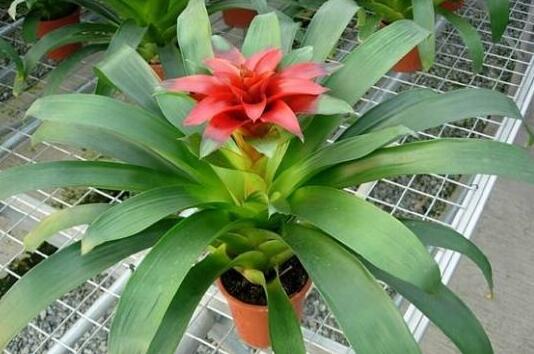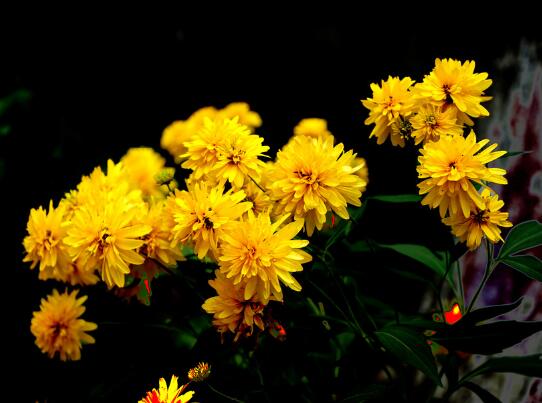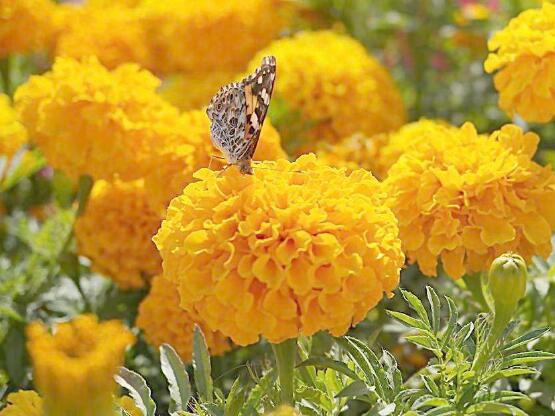Canna potted how dwarf, Canna potted cultivation method/change pot is very critical
Canna is a kind of plant that is easy to raise. We have also introduced the cultivation methods and precautions of canna in detail, but if it is planted in pots, what will be different? Today we will take a look at the method of potted culture of canna.
Pot culture method of canna
1. Choose a deeper and larger basin

Because canna is a root tuber plant, its roots will be larger than ordinary plants, so we should choose a larger basin, so that in the growth process, the root development will not be hindered by the size of the pot.
In addition, the soil should also be looser, such as rotten leaf soil, vegetable garden soil, and so on, because loose soil does not limit root development, which is a very important point in canna pot culture.
2. Control watering and fertilize more
When banana is planted in pots, attention should be paid to watering. Unlike open-field cultivation, it should be dry and wet when watering, and the soil should be drier during the dormant period, while it can be wet in summer. For more information, please refer to the detailed introduction of how canna is watered throughout the year.
In addition, when applying fertilizer, we should pay attention to adding some bone powder or organic fertilizer to the basin soil, and then apply fertilizer every half a month to a month during the growing period, mainly nitrogen, phosphorus and potassium.
3. Change the basin regularly
In the method of pot culture of canna, it is necessary to change the pot regularly, usually every 1-2 years in spring, depending on the condition of the pot soil. its purpose is to increase the air permeability of the pot soil and to ensure the good drainage of the soil.
4. should be propagated separately.
If the canna is planted in pots, the best way of propagation is to choose separate plants, which should be the way with the highest survival rate, which can be propagated by the way when changing pots, which can not only save maintenance time, but also improve the survival rate of plants after reproduction.
How to dwarf Banana in potted plants
1. Stem cutting method
Cut the rhizome of canna into small pieces, keep 2-3 buds on each piece, then choose a good pot soil and plant the cut rhizome in each flowerpot separately, generally, two rhizomes in each pot, with a depth of 8-10 cm, should be watered thoroughly after planting, and then managed according to the pot culture method of canna when the leaves grow out.
2. Select the right variety
Among the species of canna, there is a kind called dwarf canna, whose height is generally 50-70 cm, which is very suitable for potted plants, so if you want to grow indoors, you have to choose the right variety.
3. Buried paclobutrazol mud pill method
After the clay mixed with 1g 1Kg of 15% concentration is evenly mixed, add the right amount of water and make small mud balls, which are similar in size to ping-pong balls, and then set aside after drying. When the stems and leaves of canna grow to about 20cm, five mud balls are buried in the basin soil, and then the solution in the balls seeps into the roots to dwarf them.
How to dwarf Banana in potted plants
I. Stem cutting method
This method is to cut the rhizome of canna into small pieces, with two or three buds on each small piece, and then choose a larger flowerpot and plant the cut small rhizome in it, and two small pieces will be enough in each flowerpot. The depth of planting is between 8 cm and 10 cm, and the base fertilizer must be put in advance in the basin soil. After planting, it needs to be watered thoroughly, and after the leaves grow out, the normal management of water and fertilizer can be carried out, which can promote the growth of stems and leaves. When the height of the stems and leaves reaches 30cm to 40cm but has not yet blossomed, a flat stubble should be carried out, that is, all the stems should be cut off without leaving a single leaf, and a thin liquid fertilizer should be applied twice a week. If the stem is well-nourished, it will sprout again soon. At this time, it will be neatly trimmed, dwarf the stems and leaves again, and it will blossom in about a month. After flowering, in order to keep the canna blooming many times, it will blossom again in June and September with a thin stem. Usually, it will blossom again after a month.
2. buried paclobutrazol mud pill method
Some varieties of canna do grow taller, which has a great impact on ornamental. At this time, you can choose to use multi-frustration treatment so that its plants can be dwarfed. The specific method is: use 15% concentration of multi-frustration 1g mixed 1Kg clay to mix evenly, then add the right amount of water, knead the clay into small mud balls, the size of the balls can be about the size of ping-pong balls, need about 30, and then dry these mud balls. After the height of the stems and leaves of the potted canna reaches between 20 cm and 30 cm, you can use some mud balls in the potted plant, usually 5 in a flowerpot, buried on the edge of the flowerpot. After that, it is watered, in order to slowly dissolve the pharmaceutical ingredients in the mud balls, infiltrate into the roots of canna, and promote it to dwarf.
Have you learned the above methods? I hope the canna plants raised by you will become more and more beautiful.
What are the conditions of canna pot culture? what are the methods of canna pot culture?
Pot culture conditions of canna
1. Lighting: all-day sunshine, sufficient light is required during the growing period, and be sure to receive at least 5 hours of direct sunlight every day. The environment is too dark and lack of light, which will delay the flowering period. If you put it in a cool place during flowering, you can prolong the flowering period.
2. Temperature: the suitable growth temperature is 15-30 ℃. When it blossoms. In order to prolong the flowering period, it can be placed in a place with low temperature and no sunlight, and the ambient temperature should not be lower than 10 ℃. When the temperature is above 40 ℃, the canna can be moved to a cool and ventilated place. Before and after Frosts Descent, the potted canna can be moved to a temperature of 5-10 ℃ to survive the winter safely.
3. Humidity: during the growing period, water should be sprayed to the leaf surface 1-2 times a day to maintain humidity. Because the canna is very fond of fertilizer and moisture resistance, so the basin should be watered thoroughly.
4. Fertilization: in addition to applying sufficient base fertilizer before planting, topdressing should be applied 3-4 times a month in the peak growing season. If the buds are not produced 20-30 days before the scheduled flowering date, 0.2% potassium dihydrogen phosphate can be sprayed on the leaves to promote flowering. Potted canna sometimes has scorched and yellowed leaves, mainly due to excessive application of ferrous sulfate or drought and hot sun exposure. In the hot summer, if the water temperature is too cold, it will also cause scorch on the edge of the leaves. If the fertilizer is too thick in the heat of summer, it will burn the roots and make them "burn to death".
5. Soil: the requirement of soil is not strict, it grows best in loose, fertile and well-drained sandy soil, and it is also suitable for the growth of fertile clayey soil. The basin soil should be mixed with rotten leaf soil, garden soil, peat soil, mountain mud and other soil rich in organic matter. It is appropriate to choose dwarf varieties for potted canna, generally using rotten leaf soil, vegetable garden soil and rice chaff ash as raw materials, according to the ratio of 1: 1.5 and 0.5, and adding a small amount of bean cake, bone meal and other fertilizers. From March to April in spring, take out the tuber, remove the rotten part, select the stem with 2-3 strong buds and bury it in the basin soil, preferably the bud tip exposed the basin soil. Because canna is very fond of fertilizer and resistance to moisture, the basin should be watered thoroughly. When the fifth leaf grows, mature topdressing is applied every 7-10 days, and then watered after fertilization. Generally, 1% ferrous sulfate fertilizer and water is applied once a month, or a small amount of plant ash is added to make the stem straight and strong, the leaves green and thick, and the flowers bright. Stop fertilizing at the flowering stage. Stop fertilizing during the overwintering period.
6. Pruning: when the flower at the end of the stem lags behind, the stem branch should be cut off from the base at any time in order to sprout new buds and grow flower branches to blossom one after another.
Pot culture method of canna
1. The basin should be deep, large and loose: canna is a root plant, and the basin should be deeper and larger, and a tile basin with a diameter of 3040 cm can be used. It has strong adaptability and does not choose soil, so it grows best in fertile, loose and well-drained sandy loam. Rotten leaf soil and vegetable garden soil can be mixed with a small amount of sand as culture soil. When planting, it is appropriate to plant deeply and cover 68 cm of soil. Put a layer of broken hard plastic foam at the bottom of the basin to facilitate ventilation and drainage. Change the basin and soil every spring.
2. Moderate inflow and frequent fertilization: during the growing period of canna, the basin soil should be dry and wet, and waterlogging should be discharged at any time in the rainy season. The basin soil should be drier during the dormant period. Like fertilizer, in addition to adding some bone meal and nitrogen, phosphorus and potassium compound fertilizer to the culture soil during the growing period, apply nitrogen, phosphorus and potassium compound fertilizer once in the growing period, and do not apply it at flowering, continue to apply nitrogen fertilizer after flowering, avoid single application of nitrogen fertilizer, otherwise there are more leaves and less flowers. No fertilizer is applied during dormancy.
3. Like light, like warmth and fear cold: beauty steaming is a negative flower of tropical origin, which should be placed on a sunny courtyard, roof garden or west balcony with good ventilation and sunshine, so that not only the roots are big and tillers, but also the flowers are many and showy. If placed in shade, the plant will be tall, less color, light, or even no flowers. Fearing frost and snow freezing, Frosts Descent cut off all the scorched yellow leaves and buckled an empty flowerpot on the pot. the south of the Yangtze River can survive the winter safely outside, and people need rooms to survive the winter to the north of the Yangtze River. Prune the flower stem in time. For potted canna, the flower stem should be cut off from the lower part of the stem in time after flower fade, and fertilized to promote it to grow new stem from the stem root, and it can blossom again after one and a half months, so that it can blossom for 34 crops from late May to October, and always insist on beautiful flowers and leaves.
4. Ramet propagation is easy to survive: in spring, combined with changing the basin and soil, the root is poured out and cut into several pieces with a sharp knife, each with at least 23 buds. The incision is smeared with sulfur powder or charcoal and can be carried in the basin respectively. It can also be bred after anthesis and sowed and propagated in the next spring.
Prevention and control of diseases and insect pests of banana in pot cultivation
Attention should be paid to leaf curling pests from May to August every year so as not to damage their tender leaves and inflorescences. It can be sprayed with 1000 times of 50% dichlorvos or 50% EC of dichlorvos. When planting canna, tigers occasionally occur, which can be caught manually or poured into the root soil with 600-800 times solution of trichlorfon.
Well, this is the end of the method of pot culture of canna. Canna is not only of high ornamental value, but also its roots and flowers can be used as medicine. Root tubers can treat acute contaminated hepatitis such as xanthoma, hypertension and hemoptysis, and flowers can treat hemoptysis. It is a kind of medicinal and ornamental flower worthy of cultivation.
Related articles
- Prev

What should be paid attention to in the cultivation of marigold? detailed explanation of the culture method of marigold / sufficient light
First, what should be paid attention to in the cultivation of marigold? first of all, we need to understand its growth habits. Marigold is a kind of light-loving plant, and maintaining sufficient light in the process of cultivation can make it grow better. of course, we need to pay attention not only to that, but also to what else.
- Next

How to water marigold, watering methods and precautions / avoid stagnant water
Marigold is a kind of highly ornamental plant, there are many places that need to be paid attention to in the process of marigold culture, among which water is indispensable. How to water marigold? What are the watering methods and points for attention of marigold? Next, the editor will take you to learn about it.
Related
- Fuxing push coffee new agricultural production and marketing class: lack of small-scale processing plants
- Jujube rice field leisure farm deep ploughing Yilan for five years to create a space for organic food and play
- Nongyu Farm-A trial of organic papaya for brave women with advanced technology
- Four points for attention in the prevention and control of diseases and insect pests of edible fungi
- How to add nutrient solution to Edible Fungi
- Is there any good way to control edible fungus mites?
- Open Inoculation Technology of Edible Fungi
- Is there any clever way to use fertilizer for edible fungus in winter?
- What agents are used to kill the pathogens of edible fungi in the mushroom shed?
- Rapid drying of Edible Fungi

